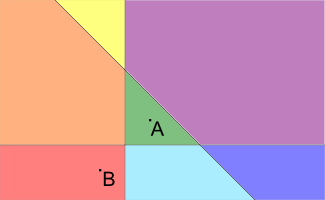1 second
256 megabytes
standard input
standard output
Crazy Town is a plane on which there are n infinite line roads. Each road is defined by the equationaix + biy + ci = 0,
whereai andbi are not both equal to the zero. The roads divide the plane into connected regions, possibly
of infinite space. Let's call each such region a block. We define an intersection as the point where at least two different roads intersect.
Your home is located in one of the blocks. Today you need to get to the University, also located in some block. In one step you can move from one block to another, if the length of their common border is nonzero (in particular, this means that if the blocks
are adjacent to one intersection, but have no shared nonzero boundary segment, then it are not allowed to move from one to another one in one step).
Determine what is the minimum number of steps you have to perform to get to the block containing the university. It is guaranteed that neither your home nor the university is located on the road.
The first line contains two space-separated integers x1,y1 ( - 106 ≤ x1, y1 ≤ 106)
— the coordinates of your home.
The second line contains two integers separated by a space
x2, y2 ( - 106 ≤ x2, y2 ≤ 106)
— the coordinates of the university you are studying at.
The third line contains an integer n (1 ≤ n ≤ 300) — the number of roads in the city. The followingn lines contain 3 space-separated integers
( - 106 ≤ ai, bi, ci ≤ 106;|ai| + |bi| > 0)
— the coefficients of the lineaix + biy + ci = 0, defining thei-th
road. It is guaranteed that no two roads are the same. In addition, neither your home nor the university lie on the road (i.e. they do not belong to any one of the lines).
Output the answer to the problem.
1 1 -1 -1 2 0 1 0 1 0 0
2
1 1 -1 -1 3 1 0 0 0 1 0 1 1 -3
2
Pictures to the samples are presented below (A is the point representing the house; B is the point representing the university, different blocks are filled with different colors):


猜测一下发现,统计AB的连线段经过多少直线即可,通过直线方程取出两点,再用叉积
#include<map>
#include<string>
#include<cstring>
#include<cstdio>
#include<cstdlib>
#include<cmath>
#include<queue>
#include<vector>
#include<iostream>
#include<algorithm>
#include<bitset>
#include<climits>
#include<list>
#include<iomanip>
using namespace std;
struct point
{
double x,y;
point()
{
}
point(double x,double y)
{
this->x=x;
this->y=y;
}
point operator -(point one)
{
return point(x-one.x,y-one.y);
}
double operator *(point one)
{
return x*one.y-y*one.x;
}
friend istream & operator >>(istream &is,point &one)
{
is>>one.x>>one.y;
return is;
}
};
struct line
{
double a,b,c;
void cg(point &one,point &two)
{
if(a==0)
{
one.y=two.y=-c/b;
one.x=1;
two.x=2;
}
else if(b==0)
{
one.x=two.x=-c/a;
one.y=1;
two.y=2;
}
else if(c==0)
{
one=point(0,0);
two=point(b,-a);
}
else
{
one=point(0,-c/b);
two=point(-c/a,0);
}
}
friend istream & operator >>(istream &is,line &one)
{
is>>one.a>>one.b>>one.c;
return is;
}
};
bool isok(point one,point two,line three)
{
point four,five;
three.cg(four,five);
return (one-four)*(five-four)*((two-four)*(five-four))<0;
}
int main()
{
point one,two;
cin>>one>>two;
int n,ans=0;
cin>>n;
while(n--)
{
line t;
cin>>t;
if(isok(one,two,t))
ans++;
}
cout<<ans;
}